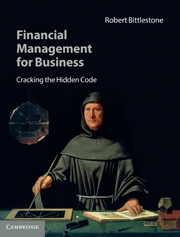Book contents
- Frontmatter
- Contents
- List of figures
- Introduction
- Acknowledgements
- Part 1 A dream of future wealth
- Part 2 The hidden art of management
- 13 The sweet spot
- 14 Elastic bands
- 15 An offer you can't refuse
- 16 The best of both worlds
- 17 Financial Perestroika on Interstate 95
- 18 Loads of money
- 19 Checkmate
- 20 Acts of God
- 21 Acts of men
- 22 Hubble, bubble, double-entry trouble
- 23 Credit crunch conclusion
- 24 Twenty-first-century accounting
- Appendix 1 Mathematical anchor
- Appendix 2 Getting to grips with cash
- Postscript
- Bibliography
- Index
16 - The best of both worlds
from Part 2 - The hidden art of management
Published online by Cambridge University Press: 05 June 2014
- Frontmatter
- Contents
- List of figures
- Introduction
- Acknowledgements
- Part 1 A dream of future wealth
- Part 2 The hidden art of management
- 13 The sweet spot
- 14 Elastic bands
- 15 An offer you can't refuse
- 16 The best of both worlds
- 17 Financial Perestroika on Interstate 95
- 18 Loads of money
- 19 Checkmate
- 20 Acts of God
- 21 Acts of men
- 22 Hubble, bubble, double-entry trouble
- 23 Credit crunch conclusion
- 24 Twenty-first-century accounting
- Appendix 1 Mathematical anchor
- Appendix 2 Getting to grips with cash
- Postscript
- Bibliography
- Index
Summary
Advertising symbolizes the art of making people dissatisfied with what they have.
Joost MeerlooIn the previous chapter we considered Product Quality as a business decision that drives two outcomes: Price Sensitivity and Unit Cost. Customers are generally willing to buy a higher quality product at a higher price, but that higher quality also costs the business more money. As we have seen, at some point an increase in quality is likely to be met by a decrease in Gross Profit, and so there is an optimal combination of both quality and price – a two-dimensional sweet spot – that provides the greatest profit return.
The problem for many businesses is that this sweet spot may correspond to a relatively modest level of actual Gross Profit, and that is before deducting all the other costs of running the business. It therefore becomes very tempting for businesses to find ways of influencing customers' Price Sensitivity by spending as little money as possible.
One way in which this can be achieved is by considering the following simple relationship:
Apparent Quality = Actual Quality + Perceived Quality
Actual Quality involves making changes to the physical nature of the product that usually cost the business a considerable amount of money, whether by buying in a more expensive source material or performing research and development to innovate something new. However, Perceived Quality can potentially be achieved at a much lower cost.
- Type
- Chapter
- Information
- Financial Management for BusinessCracking the Hidden Code, pp. 114 - 123Publisher: Cambridge University PressPrint publication year: 2010



